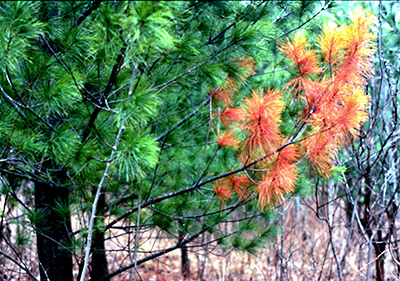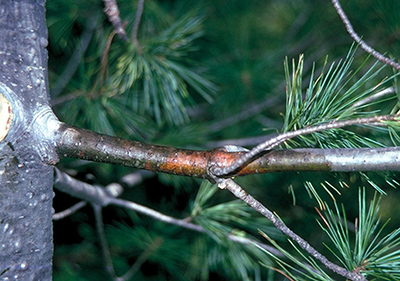White pine blister rust damage showing up
Orange-yellow blisters are a visible sign of white pine blister rust. This fungus can kill branches and even trees.

White pine blister rust (Cronartium ribicola) is the only stem rust of eastern white pine (Pinus strobus) and it requires an alternative host for new infections to occur. The alternative host is either currants or gooseberries (Ribes spp.). This fungus causes cankers that kill branches. Cankers that form on the trunk can girdle and eventually kill the tree.
The life cycle of white pine blister rust may take three to six years to complete. In the spring, pale yellow or cream-colored blisters (aecia) rupture through the bark of active cankers on white pine. These blisters will release powdery, orange-yellow spores (aeciospores) that are carried in the wind to the alternate host and cause infection. These spores can only infect Ribes species. On Ribes, the rust fungus will then produce another spore that will infect white pine in mid-summer to early fall.
As of April 2016, there are no fungicides available for prevention or treatment of white pine blister rust. Michigan State University Extension suggests the following cultural control methods:
- Pruning out infected branches and twigs as soon as they are noticed. Prune at least 2 inches below the visible canker. The majority of infections occur on pines within a few feet of the ground.
- Eliminating Ribes within a minimum of 1,000 feet of the white pine plantation to reduce the potential of infection from spores produced on nearby Ribes.

Branch flagging as a result of girdling cankers on the branch. Photo by Minnesota Department of Natural Resources, Bugwood.org.

Yellowish-green bark tissue is an early sign of the canker. Photo by John W. Schwandt, USDA Forest Service, Bugwood.org.



 Print
Print Email
Email


